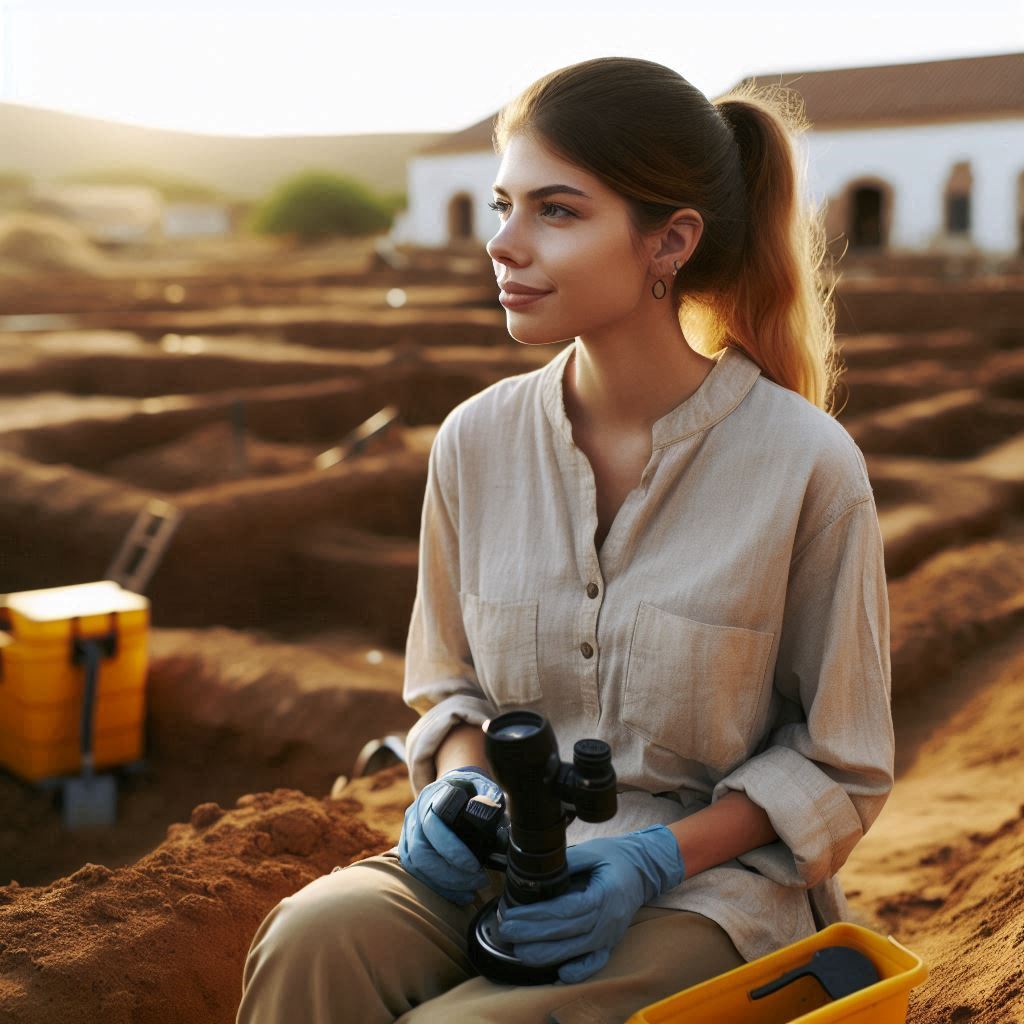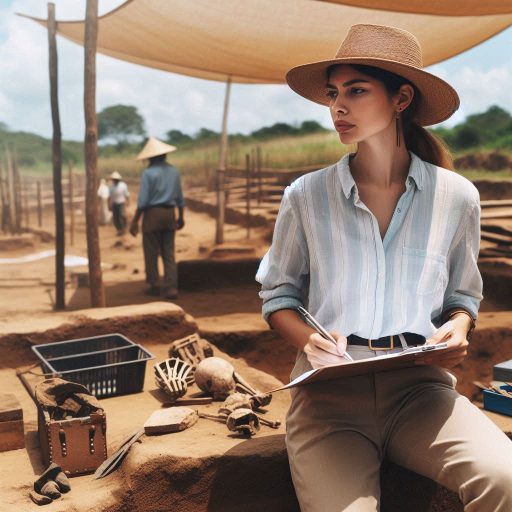Introduction
Archaeology is the study of human history through the excavation and analysis of artifacts, structures, and other physical remains.
This field plays a vital role in understanding our past, helping us piece together how cultures developed, interacted, and evolved over time.
By uncovering and interpreting the remnants of previous societies, archaeology sheds light on the complexities of human behavior, social structures, and cultural practices.
This knowledge not only enriches our understanding of history but also informs contemporary discussions about identity, heritage, and cultural preservation.
Public engagement in archaeology refers to the active involvement of communities in archaeological research, discussions, and activities.
This concept emphasizes the importance of including diverse voices and perspectives in the interpretation and dissemination of archaeological knowledge.
Public engagement can take many forms, including workshops, community excavations, educational programs, and social media outreach.
By fostering collaboration between archaeologists and the public, we can enhance the relevance of archaeological findings and encourage collective stewardship of our shared heritage.
The importance of sharing knowledge with the public cannot be overstated.
It cultivates a sense of ownership and pride in cultural heritage while promoting awareness of the significance of archaeological work.
By prioritizing public engagement, archaeologists can build bridges between academia and communities, ensuring that the stories of our past are accessible and appreciated by all.
Ultimately, this collaborative approach enriches our understanding of history and fosters a deeper appreciation for the diverse tapestry of human experience.
Importance of Public Engagement in Archaeology
Public engagement is essential in archaeology.
Involving the public in archaeological projects brings numerous benefits.
Benefits of Involving the Public in Archaeological Projects
First, it fosters a deeper connection between communities and their heritage.
When people actively participate, they gain a sense of ownership over local history.
This connection can lead to increased pride in cultural heritage.
Public involvement also enhances the quality of archaeological research.
Community members often provide local knowledge that enriches projects.
Their insights can lead to more relevant and impactful findings.
Involving the public helps raise awareness of archaeological practices.
As people engage, they learn about research methods, historical contexts, and conservation efforts.
This knowledge creates a more informed public, which can advocate for preservation and funding.
Additionally, public engagement encourages dialogue between archaeologists and the community.
Such conversations can enhance research priorities and ensure that projects reflect community interests.
How Public Engagement Raises Awareness and Appreciation for Archaeology
Successful public engagement initiatives showcase the value of involving the public.
One notable example is the “Dig for a Day” program in the United Kingdom.
This initiative allows community members to join archaeological digs, experience the process, and discover local history firsthand.
Participants often express enthusiasm and a newfound appreciation for archaeology after their involvement.
Another successful initiative is the “Community Archaeology” projects in the U.S.
These projects invite volunteers to assist in excavations and research.
They not only help in data collection but also develop skills in archaeology.
Many participants go on to become advocates for archaeological preservation in their communities.
Educational outreach programs also play a vital role in public engagement.
For example, organizations like the Archaeological Institute of America offer resources and workshops.
These programs target schools and local communities, making archaeology accessible and engaging.
They provide hands-on experiences that capture the imagination of young people.
Examples of Successful Public Engagement Initiatives in Archaeology
Social media has revolutionized how archaeology engages the public.
Archaeologists can now share discoveries and updates in real time.
Platforms like Instagram and Twitter connect professionals with interested audiences.
This instant access fosters a broader appreciation for archaeology and its findings.
Public engagement can also enhance funding opportunities for archaeological projects.
When the community recognizes the value of local history, they are more likely to support initiatives financially.
Engaged communities often advocate for increased funding and resources for archaeological work.
In summary, public engagement is crucial in archaeology.
It benefits both communities and professionals by fostering understanding and appreciation.
Successful initiatives demonstrate the power of involving the public.
As we continue to explore the past, let us prioritize sharing knowledge and engaging the public in our work.
Challenges in Public Engagement in Archaeology
Public engagement in archaeology faces several challenges.
Understanding these obstacles can help professionals develop effective strategies to enhance community involvement.
Potential Obstacles in Engaging the Public
One significant challenge is the lack of public interest in archaeology.
Many people perceive archaeology as an academic discipline, detached from their lives.
This perception can lead to apathy and disengagement from local archaeological projects.
Additionally, competing interests, such as sports or entertainment, can divert attention from cultural heritage activities.
Communication barriers also hinder public engagement.
Technical jargon and complex archaeological concepts can alienate potential participants.
If archaeologists fail to communicate their work clearly, the public may struggle to understand its significance.
Furthermore, communities with diverse cultural backgrounds may require tailored communication strategies to foster engagement.
Ethical considerations pose another challenge.
Archaeologists must navigate sensitive issues related to cultural heritage.
Some communities may view archaeological work as an intrusion or exploitation of their history.
Respecting local traditions and customs is vital for fostering trust and collaboration.
Discussion of Issues Such as Lack of Public Interest, Communication Barriers, and Ethical Considerations
Lack of public interest often stems from a disconnect between archaeological research and community values.
If people do not see how archaeology relates to their lives, they are less likely to engage.
Additionally, communication barriers can exacerbate this disconnect.
When professionals use jargon or technical language, they risk alienating the very communities they seek to involve.
Ethical considerations are crucial in archaeological engagement.
Some communities may have historical traumas related to archaeological practices.
Archaeologists must approach these communities with sensitivity, acknowledging their perspectives and concerns.
Establishing trust requires careful dialogue and a commitment to ethical practices.
Strategies for Overcoming These Challenges and Promoting Meaningful Engagement
To overcome these challenges, archaeologists can adopt several strategies.
First, they should prioritize community involvement in project planning.
Engaging local stakeholders in decision-making processes can ensure projects align with community interests.
This approach fosters a sense of ownership and investment in archaeological work.
Simplifying communication is essential for bridging gaps.
Archaeologists can use plain language and engaging visuals to convey their findings.
Hosting public talks, workshops, and interactive events can make archaeology more accessible and appealing.
Utilizing social media platforms can also facilitate real-time communication and outreach.
Ethical engagement strategies can help build trust.
Archaeologists should listen to community concerns and incorporate local knowledge into their research.
Demonstrating respect for cultural heritage can enhance relationships with local stakeholders.
Providing educational resources can empower communities to advocate for their heritage actively.
Public engagement in archaeology faces challenges, including lack of interest, communication barriers, and ethical considerations.
By recognizing these obstacles, archaeologists can develop strategies for meaningful engagement.
Prioritizing community involvement, simplifying communication, and fostering ethical practices will enhance public participation in archaeology.
Read: Educational Path: Becoming a Geologist in the USA
Methods of Sharing Knowledge in Archaeology
Sharing knowledge is vital for fostering public engagement in archaeology.
Archaeologists can utilize various methods to effectively communicate their findings and insights with the public.
These methods can help make archaeological information accessible and engaging for a wide audience.
Different Ways to Share Knowledge with the Public
One effective way to share knowledge is through public lectures.
These events allow archaeologists to present their research to interested community members.
Public lectures can cover various topics, from specific excavations to broader themes in archaeology.
They offer an opportunity for attendees to ask questions and engage in discussions, deepening their understanding of the subject matter.
Workshops provide another valuable method for sharing knowledge.
These hands-on sessions allow participants to learn about archaeological techniques and methodologies.
Workshops can include activities like pottery reconstruction, artifact analysis, or even excavation simulations.
By participating in these activities, attendees gain practical skills and a deeper appreciation for the complexities of archaeological work.
Site tours are an engaging way to connect the public with archaeological heritage.
By taking visitors to active dig sites or historical locations, archaeologists can provide firsthand experiences.
These tours allow participants to see artifacts and learn about their context.
Personal interactions with archaeologists during site tours can enhance the experience, as participants can ask questions and gain insights directly from professionals.
Educational programs play a critical role in sharing knowledge with schools and communities.
Archaeologists can develop curriculum materials or after-school programs for students.
These initiatives can introduce young people to archaeology, sparking their interest in history and culture.
Collaborating with educators ensures that the programs align with learning objectives, making them relevant and beneficial for students.
Techniques for Effective Knowledge Sharing
In addition to traditional methods, digital platforms offer innovative ways to share archaeological knowledge.
Online lectures, webinars, and virtual museum tours make information accessible to a broader audience.
Social media platforms, like Instagram and Twitter, enable archaeologists to share updates, discoveries, and insights in real time.
These platforms encourage interaction and can foster a sense of community among enthusiasts and professionals.
The importance of making archaeological information accessible cannot be overstated.
Using clear language, engaging visuals, and relatable examples helps demystify complex concepts.
Providing resources in multiple languages can also ensure inclusivity for diverse audiences.
Creating materials that cater to different age groups and learning styles enhances engagement and understanding.
The Importance of Accessibility and Engagement
Accessibility and engagement are key to successful knowledge-sharing initiatives.
When archaeological information is presented in a relatable and entertaining manner, it captures the audience’s interest.
This approach can inspire curiosity and foster a lifelong appreciation for archaeology.
Archaeologists have numerous methods to share knowledge with the public.
Public lectures, workshops, site tours, and educational programs all play vital roles.
Emphasizing accessibility and engagement in these initiatives is crucial for building a knowledgeable and appreciative audience.
By effectively sharing their findings, archaeologists can inspire a deeper connection between the public and their cultural heritage.
Read: Botany Career Fairs and Networking Events

Benefits of Sharing Knowledge in Archaeology
Sharing archaeological knowledge with the public offers numerous benefits.
This practice enhances public understanding and appreciation of the past.
It fosters community engagement and promotes the preservation of archaeological sites.
Positive Impact of Sharing Archaeological Knowledge
One significant positive impact of sharing knowledge is the increase in public awareness of archaeology’s relevance.
When communities understand the importance of their local heritage, they become more invested in its preservation.
This sense of ownership encourages individuals to advocate for the protection of archaeological sites.
Sharing knowledge can transform passive audiences into active participants in heritage conservation.
Moreover, sharing knowledge fosters collaboration between archaeologists and the public.
When communities are informed about ongoing research, they are more likely to contribute to archaeological projects.
This collaboration can lead to more comprehensive and inclusive research outcomes.
Engaging the public helps build trust and creates a shared sense of purpose.
Increased Public Understanding and Preservation of Archaeological Sites
Increased public understanding can lead to better preservation of archaeological sites.
When local communities appreciate the historical significance of these sites, they are more likely to support conservation efforts.
For example, residents may report vandalism or illegal excavations when they recognize the value of their heritage.
This vigilance plays a crucial role in protecting archaeological resources from damage.
Additionally, public engagement can generate resources for preservation initiatives.
Communities that value their heritage often seek funding or partnerships for conservation projects.
By sharing knowledge, archaeologists can empower communities to advocate for their sites, resulting in increased support for preservation efforts.
Examples of Public Engagement Leading to New Discoveries
Public engagement has directly contributed to new discoveries and insights in archaeology.
For instance, citizen science projects encourage community members to participate in data collection and analysis.
These initiatives can lead to the discovery of previously unknown sites or artifacts.
Volunteers often bring unique perspectives and local knowledge that enrich archaeological research.
One notable example is the “Archaeological Sites Program” in the U.S.
This initiative invites volunteers to help document and monitor archaeological sites.
Participants have contributed to the identification of new sites, leading to valuable research opportunities.
Such collaborations highlight the power of community involvement in advancing archaeological knowledge.
Additionally, public involvement in excavation projects can yield unexpected discoveries.
In one case, a group of volunteers uncovered a rare artifact that professional archaeologists had overlooked.
This collaboration demonstrated how public engagement can enhance research and reveal new insights into the past.
Sharing archaeological knowledge with the public has numerous benefits.
It increases awareness, fosters collaboration, and enhances preservation efforts.
Increased public understanding leads to more significant support for conservation initiatives, while community engagement can yield new discoveries.
By sharing knowledge, archaeologists create a more informed and engaged public, fostering a deeper appreciation for cultural heritage.
Ultimately, these efforts enrich the field of archaeology and ensure the protection of invaluable historical resources.
Read: Preparing for a Botany PhD: Tips and Advice
Transform Your Career Today
Unlock a personalized career strategy that drives real results. Get tailored advice and a roadmap designed just for you.
Start NowThe Role of Technology in Enhancing Public Engagement in Archaeology
Technology plays a transformative role in enhancing public engagement in archaeology.
It offers innovative ways to share knowledge and connect with diverse audiences.
By leveraging digital tools, virtual reality, and online platforms, archaeologists can make information more accessible and engaging.
Exploration of How Technology Enhances Public Engagement
Digital tools have revolutionized how archaeological information is disseminated.
Archaeologists can use Geographic Information Systems (GIS) to create interactive maps.
These maps allow the public to explore archaeological sites and their significance.
By visualizing data in an accessible format, communities can better understand the historical context of their heritage.
Moreover, social media platforms have emerged as powerful tools for engagement.
Archaeologists can share updates, discoveries, and insights in real time.
These platforms encourage interaction, enabling archaeologists to connect with a broader audience.
By sharing engaging content, such as images and videos, professionals can spark interest in archaeology and invite public participation.
Discussion of Digital Tools, Virtual Reality, and Online Platforms
Virtual reality (VR) is another groundbreaking technology that enhances public engagement.
Through VR experiences, users can virtually explore archaeological sites, regardless of their physical location.
For example, projects like “Virtual Rome” allow users to experience ancient Rome’s streets and monuments in a fully immersive way.
Such experiences can ignite curiosity and encourage people to learn more about archaeology.
Online platforms also facilitate knowledge sharing.
Websites dedicated to archaeological research can provide access to a wealth of information.
These platforms can include articles, educational resources, and databases of artifacts.
By making information easily accessible, archaeologists can reach diverse audiences, including students, educators, and community members.
Examples of Successful Projects Utilizing Technology
Several successful projects have harnessed technology to engage the public in archaeology.
One notable example is the “Digital Archaeological Archive of Comparative Slavery” (DAACS).
This online platform allows users to access archaeological data and artifacts from various slavery sites.
The platform provides valuable resources for researchers and educators, fostering a broader understanding of this complex history.
Another successful initiative is the “Archaeology in the Community” project.
This program uses social media and interactive websites to engage local communities in archaeological research.
By providing updates and inviting participation, the project fosters a sense of ownership among community members.
It has led to increased awareness and advocacy for archaeological preservation.
The “Heritage Together” project also exemplifies technology’s role in public engagement.
This initiative uses mobile applications to provide guided tours of archaeological sites.
Visitors can access multimedia content, including audio guides and videos, enhancing their experience.
Such applications make archaeological information more engaging and accessible to a wide audience.
Technology plays a vital role in enhancing public engagement in archaeology.
By utilizing digital tools, virtual reality, and online platforms, archaeologists can share knowledge more effectively.
Successful projects demonstrate how technology can foster interest and participation in archaeology.
As technology continues to evolve, it will provide new opportunities to connect the public with their cultural heritage.
By embracing these advancements, archaeologists can create a more informed and engaged audience, ensuring the continued relevance of their work.
Read: Interdisciplinary Research: Botany and Other Sciences
Collaboration with Indigenous Communities in Archaeology
Collaboration with Indigenous communities is crucial in archaeological research and public engagement.
This partnership fosters a more inclusive understanding of history and heritage.
By involving Indigenous peoples, archaeologists can enrich their work and ensure respectful representation of diverse cultural narratives.
Importance of Collaborating with Indigenous Communities
Collaborating with Indigenous communities acknowledges their historical connections to the land and cultural heritage.
Indigenous peoples possess invaluable traditional knowledge that can enhance archaeological research.
Their insights provide context and depth to findings, leading to a more comprehensive understanding of the past.
This collaboration ensures that archaeological projects reflect the perspectives of those most affected by historical events.
Furthermore, collaboration builds trust between archaeologists and Indigenous communities.
By engaging in meaningful dialogue, archaeologists demonstrate respect for Indigenous knowledge and culture.
This fosters a sense of shared purpose and encourages ongoing partnerships.
Trust is essential for successful public engagement, as it enables communities to feel valued and involved in the research process.
Benefits of Sharing Knowledge with Local Communities
Sharing knowledge with local Indigenous communities offers numerous benefits.
First, it promotes cultural pride and revitalization.
When Indigenous peoples see their histories and traditions honored in archaeological work, it strengthens their identity.
This recognition can lead to renewed interest in cultural practices and traditions, enhancing community cohesion.
Incorporating traditional knowledge into archaeological research also leads to better outcomes.
Indigenous perspectives can inform site management and preservation strategies.
For instance, traditional ecological knowledge can guide sustainable practices in archaeological sites.
This collaborative approach ensures that both scientific and Indigenous viewpoints contribute to heritage management.
Moreover, public engagement initiatives that include Indigenous communities can create awareness among broader audiences.
Collaborative projects can highlight the rich cultural heritage of Indigenous peoples, fostering appreciation and respect.
Engaging the public in this way promotes a more nuanced understanding of history and encourages dialogue about Indigenous rights and representation.
Ethical Considerations and Best Practices for Engagement
Engaging with Indigenous communities in archaeological projects requires careful consideration of ethical practices.
First and foremost, archaeologists must seek informed consent before beginning any research.
This includes transparent communication about the goals and implications of the project.
Respect for Indigenous rights is paramount, and archaeologists must prioritize the interests of the communities involved.
Additionally, archaeologists should approach collaborations as equal partnerships.
This means valuing Indigenous knowledge and perspectives alongside scientific methods.
By fostering mutual respect, archaeologists can build stronger relationships with Indigenous communities.
Creating a space for Indigenous voices in research decisions ensures that projects reflect the interests and concerns of all parties.
Best practices for engaging with Indigenous groups also include ongoing communication and feedback.
Archaeologists should establish open lines of dialogue throughout the project, allowing for adjustments based on community input.
Regular updates and shared findings can help maintain trust and foster a sense of ownership among Indigenous partners.
Collaboration with Indigenous communities is essential for ethical and effective archaeological research.
By recognizing the importance of Indigenous perspectives, archaeologists can enrich their work and foster meaningful public engagement.
Sharing knowledge with local communities promotes cultural pride and enhances research outcomes.
Ethical considerations and best practices ensure that collaborations are respectful and equitable.
Ultimately, such partnerships contribute to a more inclusive understanding of history and heritage, benefiting both archaeologists and Indigenous peoples alike.
Conclusion
Public engagement plays a crucial role in archaeology.
It fosters a deeper understanding of our shared heritage and creates lasting connections between communities and their histories.
When archaeologists actively involve the public in their work, they spark interest and curiosity about the past.
Engaging with archaeological findings allows individuals to develop personal connections to history, leading to a greater appreciation for diverse cultures and historical narratives.
Archaeologists should prioritize sharing knowledge with the public.
They can utilize various methods, such as workshops, lectures, and social media, to reach wider audiences and engage different demographics.
By making their work more accessible, archaeologists can break down barriers and invite everyone to participate in the conversation about our past.
Moreover, public engagement can lead to increased support for archaeological initiatives.
When communities understand the value of archaeology, they are more likely to advocate for its preservation and funding.
Public involvement can also result in volunteers helping with excavations or educational programs, enhancing the archaeological experience for everyone involved.
Emphasizing public involvement not only enriches the field but also cultivates informed advocates for the future.
Archaeologists have a unique opportunity to share the stories of our past while promoting critical thinking about cultural heritage.
By engaging the public in this vital work, we can inspire future generations to appreciate and protect our shared history.




